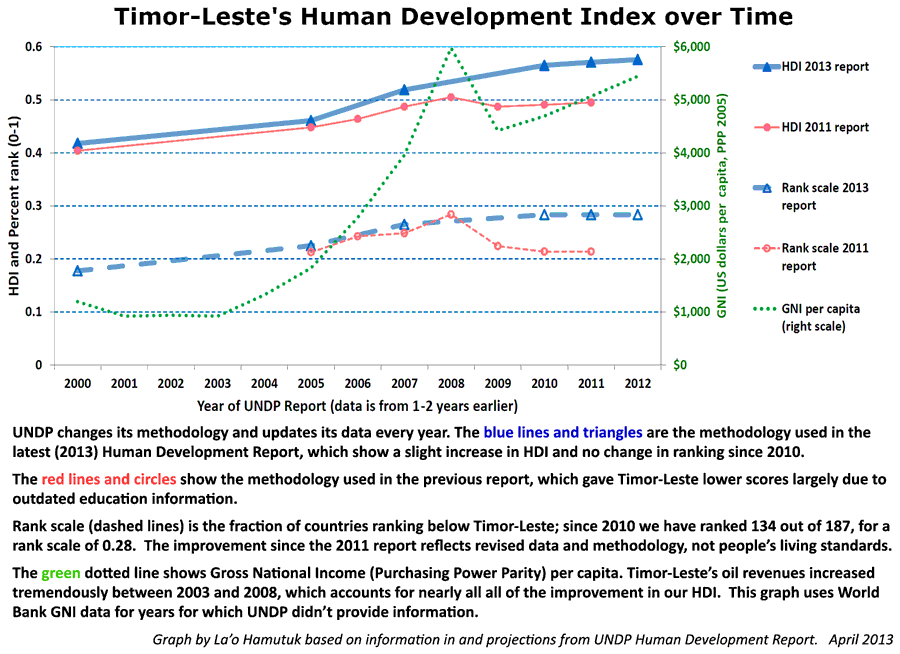 Since 1990, the United Nations Development Program (UNDP) has issued its Human Development Report almost every year. The edition published on 14 March 2013 is entitled The Rise of the South: Human Progress in a Diverse World, and includes important trends and examples of developing countries in the South improving the lives of their people. In addition to the thematic discussion and a wealth of statistical data on health, education, gender, economics and other aspects of human society, the UNDP calculates a “Human Development Index” (HDI) for each country. The HDI combines life expectancy, education (years of school enrollment) and income (Gross National Income/GNI per capita) to produce a composite measure of human development.
Since 1990, the United Nations Development Program (UNDP) has issued its Human Development Report almost every year. The edition published on 14 March 2013 is entitled The Rise of the South: Human Progress in a Diverse World, and includes important trends and examples of developing countries in the South improving the lives of their people. In addition to the thematic discussion and a wealth of statistical data on health, education, gender, economics and other aspects of human society, the UNDP calculates a “Human Development Index” (HDI) for each country. The HDI combines life expectancy, education (years of school enrollment) and income (Gross National Income/GNI per capita) to produce a composite measure of human development.The new report, based mainly on data from 2011, calculates a 2012 HDI for Timor-Leste of 0.576. UNDP categorizes Timor-Leste in the "medium human development group," ranking 134th of 187 countries with data. See UNDP's Timor-Leste-specific press release, statistical summary and explanatory note which provides detail for the general discussion in the previous paragraph. We also posted UNDP's global data spreadsheet (slightly enhanced by La'o Hamutuk). It is a gold mine with data on hundreds of indicators for nearly 200 countries and territories.
Although Timor-Leste moved up 13 rank positions compared with last year's 2011 report, UNDP cautions not to compare reports published at different times. Using a revised methodology and updated data for prior years, UNDP recalculated Timor-Leste's 2011 HDI to be 0.571, and our 2010 HDI is now 0.565. Timor-Leste's ranking did not change; we ranked 134 out of 187 countries in 2010, 2011 and 2012. LUSA and other media reported this incorrectly, but UNDP had explained it clearly.
The slight HDI improvement over the last two years is largely because GNI (gross national income per capita, adjusted for inflation) increased from $4,700 to $5,400 between 2010 and 2012, and because people are living a little longer. Three-fourths of our GNI is petroleum revenues, which do not go directly to Timorese individuals. The larger HDI gains since 2000 and 2005 reflect that oil revenues were zero in 2000 and have increased five-fold since 2005, as the green dotted line on the graph above shows.
UNDP also calculates a Multi-Dimensional Poverty Index (MPI) for each country, representing the percentage of people living in households where at least one person is deprived of education, health or standard of living. Based on data from the 2009/2010 Demographic and Health Survey, UNDP calculated that 68.1% of Timor-Leste's people live in multidimensional poverty, with an additional 18.2% "vulnerable to multiple deprivations." In other words, six out of every seven Timor-Leste citizens face major obstacles to improving their lives, which creates a huge challenge for Government, international agencies, civil society organizations and our people.
Some local media inaccurately reported that UNDP had said that 68.1% of Timor-Leste's people live below the poverty line. These press reports angered the Minister of Finance, who abruptly cancelled two meetings with UN agencies.
UNDP recognizes that income is not the best measure of human development, so they also calculate a non-income HDI based only on health and education, which was .569 for Timor-Leste in 2012. When ranked in comparison with other countries, Timor-Leste ranks 29 places better on income than our HDI ranking, meaning that our people have lower human development than other countries with the same cash income.
The Human Development Report also measures how much inequality there is in each country, and Timor-Leste's inequality-adjusted Human Development Index is .386, 33% lower than our HDI when inequality is not considered. Because many other impoverished countries are also very unequal, our ranking only drops three places when inequality is considered.
Our web page includes a table with data for Timor-Leste and a few other countries from the 2013 Human Development Report, as well as links to additional data from UNDP.




No comments:
Post a Comment